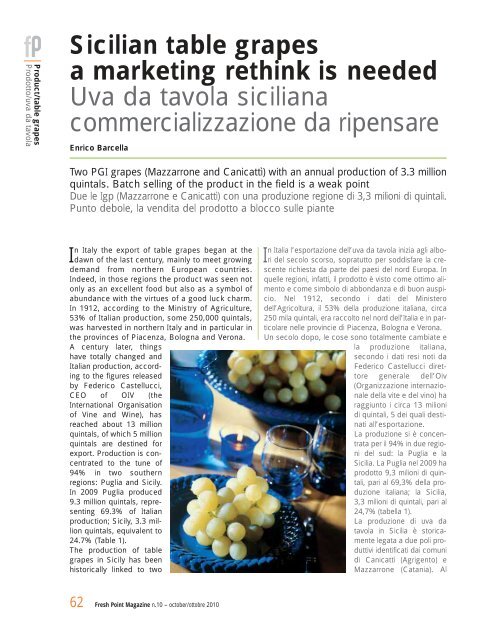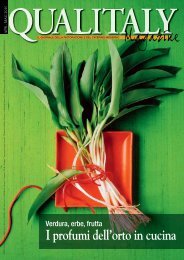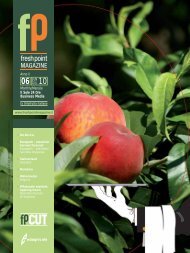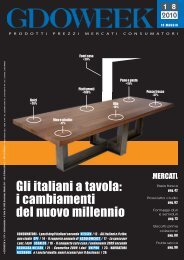Fresh Point Magazine - B2B24 - Il Sole 24 Ore
Fresh Point Magazine - B2B24 - Il Sole 24 Ore
Fresh Point Magazine - B2B24 - Il Sole 24 Ore
Create successful ePaper yourself
Turn your PDF publications into a flip-book with our unique Google optimized e-Paper software.
Product/table grapes<br />
Prodotto/uva da tavola<br />
Sicilian table grapes<br />
a marketing rethink is needed<br />
Uva da tavola siciliana<br />
commercializzazione da ripensare<br />
Enrico Barcella<br />
Two PGI grapes (Mazzarrone and Canicattì) with an annual production of 3.3 million<br />
quintals. Batch selling of the product in the field is a weak point<br />
Due le Igp (Mazzarrone e Canicattì) con una produzione regione di 3,3 milioni di quintali.<br />
Punto debole, la vendita del prodotto a blocco sulle piante<br />
In Italy the export of table grapes began at the<br />
dawn of the last century, mainly to meet growing<br />
demand from northern European countries.<br />
Indeed, in those regions the product was seen not<br />
only as an excellent food but also as a symbol of<br />
abundance with the virtues of a good luck charm.<br />
In 1912, according to the Ministry of Agriculture,<br />
53% of Italian production, some 250,000 quintals,<br />
was harvested in northern Italy and in particular in<br />
the provinces of Piacenza, Bologna and Verona.<br />
A century later, things<br />
have totally changed and<br />
Italian production, according<br />
to the figures released<br />
by Federico Castellucci,<br />
CEO of OIV (the<br />
International Organisation<br />
of Vine and Wine), has<br />
reached about 13 million<br />
quintals, of which 5 million<br />
quintals are destined for<br />
export. Production is concentrated<br />
to the tune of<br />
94% in two southern<br />
regions: Puglia and Sicily.<br />
In 2009 Puglia produced<br />
9.3 million quintals, representing<br />
69.3% of Italian<br />
production; Sicily, 3.3 million<br />
quintals, equivalent to<br />
<strong>24</strong>.7% (Table 1).<br />
The production of table<br />
grapes in Sicily has been<br />
historically linked to two<br />
62 <strong>Fresh</strong> <strong>Point</strong> <strong>Magazine</strong> n.10 – october/ottobre 2010<br />
In Italia l’esportazione dell’uva da tavola inizia agli albori<br />
del secolo scorso, sopratutto per soddisfare la crescente<br />
richiesta da parte dei paesi del nord Europa. In<br />
quelle regioni, infatti, il prodotto è visto come ottimo alimento<br />
e come simbolo di abbondanza e di buon auspicio.<br />
Nel 1912, secondo i dati del Ministero<br />
dell’Agricoltura, il 53% della produzione italiana, circa<br />
250 mila quintali, era raccolto nel nord dell’Italia e in particolare<br />
nelle provincie di Piacenza, Bologna e Verona.<br />
Un secolo dopo, le cose sono totalmente cambiate e<br />
la produzione italiana,<br />
secondo i dati resi noti da<br />
Federico Castellucci direttore<br />
generale dell’Oiv<br />
(Organizzazione internazionale<br />
della vite e del vino) ha<br />
raggiunto i circa 13 milioni<br />
di quintali, 5 dei quali destinati<br />
all’esportazione.<br />
La produzione si è concentrata<br />
per il 94% in due regioni<br />
del sud: la Puglia e la<br />
Sicilia. La Puglia nel 2009 ha<br />
prodotto 9,3 milioni di quintali,<br />
pari al 69,3% della produzione<br />
italiana; la Sicilia,<br />
3,3 milioni di quintali, pari al<br />
<strong>24</strong>,7% (tabella 1).<br />
La produzione di uva da<br />
tavola in Sicilia è storicamente<br />
legata a due poli produttivi<br />
identificati dai comuni<br />
di Canicattì (Agrigento) e<br />
Mazzarrone (Catania). Al
















